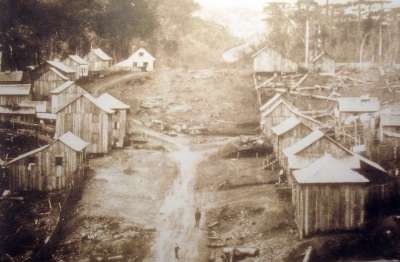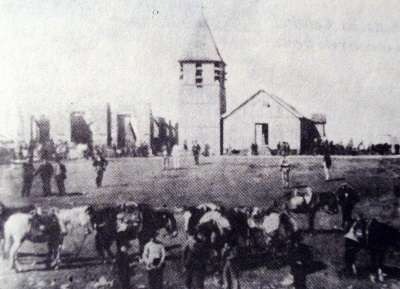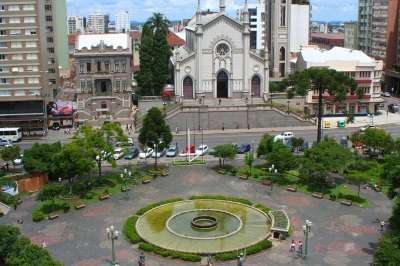|

A Praça Dante Alighieri é o logradouro público mais antigo e tradicional de Caxias do Sul, no Brasil, estando localizada no coração da cidade. Foi definida na planta da colônia desde os primórdios da ocupação do território e foi o cenário de inúmeros eventos importantes, possuindo em seu entorno diversos edifícios históricos de grande relevo.
A criação de uma praça em Caxias do Sul estava prevista desde a fundação da colônia italiana em 1875, no mesmo local onde hoje se encontra. Em sua origem, sua topografia era outra, sendo um largo bastante mais elevado do que é hoje. Até 1880, não há notícia de benfeitorias, a área era apenas um quadrado de terra batida e a urbanização incipiente no entorno avançava indevidamente sobre alguns de seus trechos. Essas estruturas foram removidas em 1882, após a aprovação de uma reforma do plano de ocupação do solo urbano, que incluiu a retificação das suas ruas delimitantes.

O núcleo urbano primitivo de Caxias do Sul em torno de 1880,
mostrando a abertura da Rua Grande e da futura Praça Dante Alighieri.
Logo em seguida começaram as obras de urbanização, com a construção de alguns balaústres para cercamento e, ao redor, começaram a ser erguidos em definitivo prédios comerciais, hotéis e casas recreativas, formando o embrião do atual Centro Histórico de Caxias do Sul. Na área da praça se instalaram alguns quiosques para venda de bebidas e petiscos diversos, e o local também recebia circos e quitandas, definindo-se como um ponto de encontro e confraternização da população.
Na administração de José Penna de Moraes, elaboraram-se planos para melhoramentos, sendo rebaixado o seu nível com a remoção de 1200 m³ de rochas. Foi ajardinada, recebeu bancos e cerca, um muro de contenção no alinhamento da rua Júlio de Castilhos, calçaram-se os passeios do entorno e foram instalados os monumentos a Júlio de Castilhos, obra de Prosperi, e a Dante Alighieri, trabalho do italiano Eugenio Bellotto. Também foi erguido um coreto para discursos de autoridades e apresentações de banda.

Vista da Praça Dante no final do século XIX, com a primeira Matriz.
Em 1917, recebeu o Chalé Municipal, uma réplica em alvenaria dos tradicionais quiosques de madeira, com um bar, restaurante e salas de jogos. Em 1922, no centenário da Independência do Brasil, foi inaugurado um monumento à Liberdade, com uma estátua de autoria de Michelangelo Zambelli e pedestal de Silvio Toigo. Em 1927 iniciaram-se outras obras de nivelamento e benfeitorias, que se prolongaram até 1940, e incluíram um novo ajardinamento com profusão de roseiras, a construção de um chafariz e o calçamento das alamedas com mosaico de pedra. Entretanto, em 27 de agosto de 1933, defronte à catedral, lançou-se a pedra fundamental do monumento ao Duque de Caxias.
Durante a II Guerra Mundial, com a onda de xenofobia que grassou pelo Brasil, o nome da praça foi alterado para Praça Rui Barbosa, após violentas manifestações populares. Na década de 1970 foi instalado um novo chafariz e a praça foi ampliada, absorvendo um trecho da avenida Júlio de Castilhos, transformado em calçadão. Em 1990, o poder público propôs a reabilitação da memória de Dante Alighieri, restaurando a antiga denominação da praça, o que ocorreu em 12 de junho. No início do século XXI, o trecho do calçadão foi novamente aberto ao tráfego de veículos e o logradouro foi completamente reajardinado.
A praça preserva atualmente uma configuração geral bastante próxima daquela estabelecida nos anos 1940, mas o seu entorno de prédios históricos sofreu profunda descaracterização ao longo do século XX, perdendo-se edifícios notáveis como a antiga sede do Banco Nacional do Comércio, o Hotel Pezzi e a primeira sede da Intendência, e nas últimas décadas os seus remanescentes foram ainda mais descaracterizados por reformas arbitrárias e por grandes placas publicitárias instaladas nas fachadas, ocultando grande parte de seus elementos.

Vista atual da praça
No entanto, a Municipalidade tem desenvolvido alguns programas de revitalização, como o Caminhos da Memória, que incluem a praça, existe legislação protegendo a arquitetura com mais de 50 anos de idade, vários imóveis do entorno foram tombados, foi aprovada legislação minimizando os impactos da poluição visual nos edifícios do Centro Histórico e, lentamente, a população parece estar despertando para a importância da preservação do patrimônio local, embora ainda muito trabalho neste sentido ainda precise ser feito para impedir que novas descaracterizações ocorram, como as que recentemente sofreram a Catedral e a Casa Canônica, os dois mais relevantes edifícios históricos que ainda sobrevivem no entorno, e que ainda não receberam o benefício do tombamento.
A praça ainda preserva diversas placas comemorativas a cidadãos ilustres caxienses e eventos importantes, bem como o Marco Zero da cidade. Outros edifícios significativos do entorno são a Casa Scotti, a Casa Sassi e a sede social do Clube Juvenil.
|
|

Dante Alighieri Square is the oldest and most traditional public place in Caxias do Sul, Brazil, being located in the heart of the city. It was defined in the plant of the colony from the beginnings of the occupation of the territory and was the scene of numerous important events, possessing in its surroundings several historical buildings of great relief.
The creation of a square in Caxias do Sul was planned from the foundation of the Italian colony in 1875, in the same place where it is today. In its origin, its topography was another, being quite a broad one more than it is today. Until 1880, there was no news of improvements, the area was only a square of beaten earth and the incipient urbanization in the surroundings was advancing unduly on some of its stretches. These structures were removed in 1882, following the approval of a reform of the urban land occupation plan, which included rectifying its delimiting streets.

Caxias do Sul primitive nucleus, around 1880,
showing the opening of Grande street and the future Dante Alighieri Square.
Soon after, urbanization began, with the construction of some balusters for enclosure and, around, began to be erected in definitive commercial buildings, hotels and recreational houses, forming the embryo of the current Historic Center of Caxias do Sul. In the area some kiosks were set up for the sale of drinks and various snacks, and the place also received circuses and greengrocers, defining itself as a meeting point and fraternization of the population.
In the administration of José Penna de Moraes, plans were made for improvements, and its level was lowered by the removal of 1200 m³ of rocks. It was landscaped, received benches and fence, a retaining wall in the alignment of Júlio de Castilhos street, the sidewalks of the surroundings were put together and the monuments were installed to Julio de Castilhos, work of Prosperi, and to Dante Alighieri, work of the Italian Eugene Bellotto. A bandstand was also erected for official speeches and band performances.

View of Dante Square in the end of the XIX century, with the first cathedral.
In 1917, it received the Municipal House, a replica masonry of the traditional wooden kiosks, with a bar, restaurant and games rooms. In 1922, in the centenary of the Independence of Brazil, a monument to Freedom was inaugurated, with a statue by Michelangelo Zambelli and Silvio Toigo's pedestal. In 1927 other leveling and improvement works began, which lasted until 1940, and included a new landscaping with profusion of rose bushes, the construction of a fountain and the pavement of stone-paved malls. However, on August 27, 1933, in front of the cathedral, the cornerstone of the monument to the Duke of Caxias was laid.
During World War II, with the wave of xenophobia that raged throughout Brazil, the name of the square was changed to Praça Rui Barbosa, after violent popular demonstrations. In the 1970s a new fountain was installed and the square was enlarged, absorbing a stretch of Júlio de Castilhos Avenue, transformed into a boardwalk. In 1990, the public power proposed the rehabilitation of the memory of Dante Alighieri, restoring the old denomination of the square, which occurred on June 12. At the beginning of the 21st century, the section of the boardwalk was again opened to vehicular traffic and the public place was completely re-reopened.
The plaza currently preserves a general configuration very close to that established in the 1940s, but its surroundings of historic buildings suffered a profound decharacterization throughout the 20th century, missing out on notable buildings such as the former headquarters of the National Bank of Commerce, the Pezzi Hotel and the first headquarters of the Intendance, and in recent decades its remnants were even more uncharacterized by arbitrary reforms and large advertising panels installed on the facades, hiding much of its elements.

Present view of the square
However, the Municipality has developed some revitalization programs, such as the Paths of Memory, which include the square, there is legislation protecting the architecture with more than 50 years of age, several surrounding properties were dropped, legislation was passed minimizing the impacts of visual pollution in the buildings of the Historical Center, and slowly the population seems to be awakening to the importance of preserving local heritage, although much work still needs to be done to prevent new characterizations from occurring, such as those recently suffered by the Cathedral and the Canonic House, the two most important historic buildings that still survive in the surroundings, and that have not yet received the benefit of the tipping.
The square still preserves several plaques commemorating prominent citizens of the region and important events, as well as the Zero Landmark of the city. Other significant buildings in the surroundings are Casa Scotti, Casa Sassi and the headquarters of the Youth Club.
|